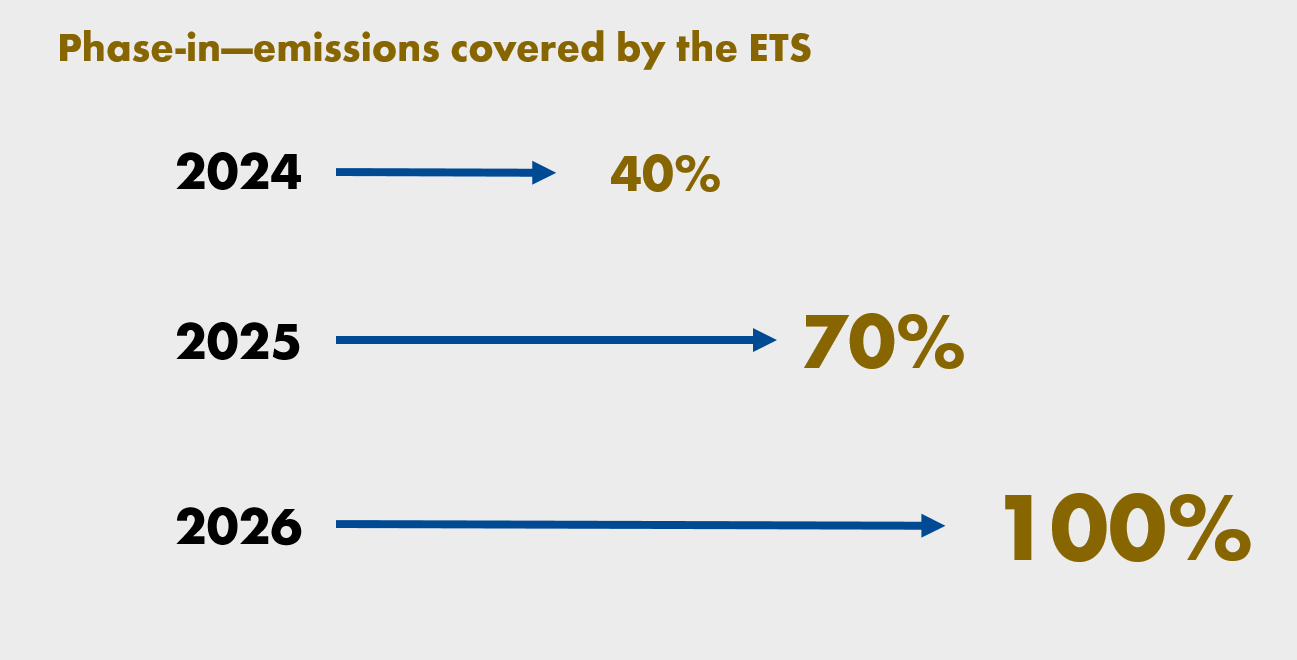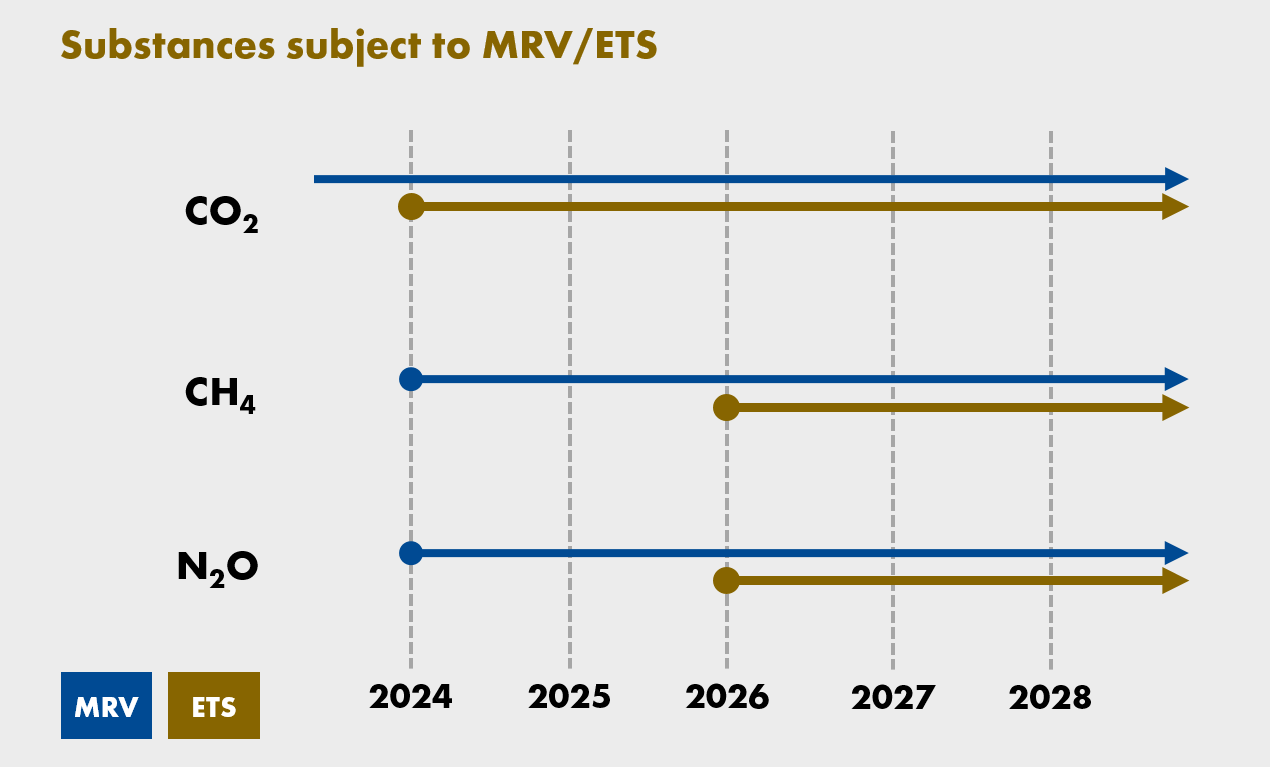Maritime transport covered by the emissions trading scheme
The EU legislative process related to adoption of key legal acts under the “Fit for 55” package is coming to an end. One of its elements is gradual integration of the maritime transport sector into the EU greenhouse gas emissions trading system (EU ETS).
The path of the maritime sector to the EU ETS
Calls for the shipping sector to be included in the EU greenhouse gas emissions reduction policy emerged shortly after the launch of the EU ETS. Difficult negotiations and legislative work have been going on for many years to achieve this challenging objective.
Maritime transport is one of the most internationalised sectors of the economy. It is covered by the requirements of supra-regional international conventions and, in particular, provisions adopted under the auspices of the International Maritime Organization (IMO). Therefore, EU provisions seeking to reduce greenhouse gas emissions are regarded as a local instrument. On the other hand, if this scheme applied only to shipping between ports of EU member states, it would fall far short of reaching the climate goals, as such a regulation would cover only a negligible percentage of global emissions linked to maritime transport. On the other hand, introduction of more ambitious solutions for bringing global maritime transport under EU regulation would inevitably risk a collision with solutions adopted at the IMO forum, and is also partly impossible due to the limitations on the binding force of EU law. The European Commission considered that a worldwide approach led by the IMO would be most appropriate. But the slow pace of the IMO’s work has forced the European Union to take the initiative, as the climate crisis urgently requires implementation of ambitious measures.
Introduction of a system with three components was considered a prerequisite for the effectiveness of EU solutions:
- Emissions monitoring, reporting and verification (MRV) system
- Reduction targets
- Market-based measures (MBMs).
Additionally, the requirements to reduce emissions from ships will only be effective if they are complemented by comprehensive supporting solutions, such as financial incentives, land infrastructure modernisation related to port electrification, availability of alternative fuels, etc.
EU MRV—emissions monitoring, reporting and verification system
Chronologically, however, the primary goal was to obtain complete and reliable information on greenhouse gas emissions from individual ships during voyages to EU ports.
This is the purpose of Regulation (EU) 2015/757 of the European Parliament and of the Council of 29 April 2015 on the monitoring, reporting and verification of carbon dioxide emissions from maritime transport, supplemented by a package of delegated and implementing regulations.
The regulation establishes the rules for monitoring, reporting and verification of carbon dioxide emissions and other relevant information from ships arriving at, within or departing from ports under the jurisdiction of member states.
It applies to ships above 5,000 gross tonnage (GT) in respect of CO2 emissions released by these ships:
- During voyages from the last port of call to a port of call under the jurisdiction of a member state
- During voyages from a port of call under the jurisdiction of a member state to the next port of call
- Within a port of call under the jurisdiction of a member state.
From 2018, the regulation made it mandatory to monitor individual ship performance parameters (CO2 emissions, fuel consumption, etc). And in 2019 a reporting obligation emerged, requiring the submission of emission reports to the Commission and the relevant national authority responsible for administering the system (in Poland, Polski Rejestr Statków SA). These reports are verified by independent entities, and meeting the requirements of the regulation is confirmed by issuance of a document of compliance.
EU ETS: Emissions trading including maritime transport
More concrete proposals for integrating the maritime sector more fully into the EU policies came with the announcement of the European Green Deal and subsequent enactment of a regulation known as the European Climate Law. This regulation made achieving climate neutrality a legally binding commitment. According to the regulation, greenhouse gas emissions and absorption across the EU should be balanced by 2050 at the latest by reducing emissions to net zero by that date, after which the EU should aim for negative emissions. Instead, the intermediate goal became a reduction of net greenhouse gas emissions (emissions net of absorption) in the EU by 2030 by at least 55% compared to levels in 1990. At the same time, it was recognised that the transition to climate neutrality requires ambitious actions across all sectors of the economy, including energy, industry and transport.
Announced in July 2021, the “Fit for 55” package of legislative proposals to make these climate ambitions a reality expressly includes expansion of the emissions trading system to include the maritime economy, road transport and buildings. It was to be accompanied by supporting solutions for ensuring the availability of renewable and low-carbon fuels (the FuelEU Maritime initiative), development of alternative fuel infrastructure (AFIR) and renewable energy sources.
With regard to the emissions trading scheme, the Commission’s initial proposal included in the “Fit for 55” package was subject to amendments, on which a preliminary agreement was reached within the EU in December 2022. On 18 April 2023, the legislative proposals were dealt with by the European Parliament, and on 25 April 2023 they were adopted by the Council. Once the new provisions are published in the Official Journal of the European Union, they will become law.
The greenhouse gas emissions trading scheme has been widely used in the EU for more than a decade. In operation since 2005, the system is a legal and economic measure based on the principle of cap and trade, combining legal restrictions on emissions with market-based instruments. In simple terms, it allows participants in the system within certain emission limits to dispose of EU allowances (EUAs). Each allowance corresponds to the emission into the air of the equivalent of one tonne of carbon dioxide. Annually, the participants are required to account for their emissions through the surrender of an appropriate number of allowances. Entities that have managed to reduce their emissions have free allowances at their disposal, which can be traded. They are acquired by other operators whose emission needs are greater. The number of allowances available on the market is not unlimited, and thus they have a specific asset value. A gradual reduction in their number causes an increase in their price, and in turn, a higher allowance price serves as an incentive to reduce greenhouse gas emissions.
Overview of changes for including the maritime transport sector in the EU ETS
Bringing shipping under the EU ETS is a complex, long-term process. Different categories of ships and greenhouse gases will be included in it in several stages.
First, greenhouse emissions from shipping will be included in the system gradually over the coming years (phase-in). The obligation to surrender allowances will apply to 40% of verified emissions for 2024, 70% for 2025 and 100% for 2026.

Second, the new rules provide for gradual inclusion of ships in the system and gradual inclusion of more greenhouse gases in the system. Since a prerequisite for proper functioning of the EU ETS is to ensure reliable monitoring of emissions, the EU MRV regulation also had to be modified to include emissions of other greenhouse gases and emissions from new categories of ships. This means that obligations for specific types of ships and greenhouse gases enter into force successively.
Thus, vessels above 5,000 GT, already covered by the EU MRV system, will be included in the EU ETS as early as 2024. However, offshore ships will first be included in the EU MRV system and only later in the EU ETS. By the end of 2026, the Commission should submit a report and possibly legislative proposals for inclusion of ships in the system, including offshore ships, with a gross tonnage below 5,000 GT but not less than 400 GT.

It is similar in the case of further greenhouse gases. Starting in 2024, methane (CH4) and nitrous oxide (N2O) emissions will be included in the monitoring, reporting and verification system, and only then will these compounds be included in the EU ETS.

Third, the requirements for submission of EUAs for maritime transport activities will apply to:
- 50% of emissions from ships on voyages that depart from a port of call of an EU state and arrive at a port of call not under the jurisdiction of any EU state
- 50% of emissions from ships on voyages that depart from a port of call not under the jurisdiction of a member state and arrive at a port of call of an EU state
- 100% of emissions from ships on voyages between ports of call of EU states
- 100% of emissions at a port of call in an EU state.
The future is uncertain
The current geopolitical and economic instability has not prevented the EU from embracing ambitious climate solutions.
There is no doubt that inclusion of shipping in the emissions trading system will have a significant impact on the operation of this sector. It will also affect relationships between various participants in maritime transport (shipowners, charterers, etc). The natural consequence will be an increase in transport costs to EU ports. In sea shipping, the possibility of using alternative fuels and zero-emission propulsion is still limited. The relatively slow implementation of new technological solutions and long operating life of ships make it impossible to decarbonise the maritime transport sector in such a short time. Additionally, the Commission assumes that actions will be taken to detect evasion of the new regulations by avoiding ports, relocating transshipment hubs, etc. Introduction of ambitious climate solutions must not lead market participants to take actions increasing emissions through additional transshipments, use of other types of transport on certain sections, etc.
For this purpose, the new provisions contain an extensive regulation aimed at eliminating the risk of EU ETS avoidance, as well as supporting those participants in the maritime economy that will be the most affected by the changes under the new provisions. The EU solutions even provide for interference in relationships between various participants in maritime transport by entitling shipping companies to demand reimbursement of costs resulting from surrender of allowances when the responsibility for purchase of fuel or operation of the ship (and thus activities affecting the ship emissions) is borne by another entity. The idea is that the cost burden for purchase and surrender of allowances should fall on the participants with the greatest impact on a ship’s emission, for example by making purchasing decisions regarding fuel type and the like.
The ongoing parallel work within the IMO on reducing greenhouse gas emissions from ships, as well as uncertainty about the market reaction and operation of the maritime transport sector once it is included in the EU ETS system, mean that the European Commission will monitor its operation on an ongoing basis and, if necessary, propose adjustments to adapt to changing market conditions and the progress of work under international instruments.
Dr Dominik Wałkowski, adwokat, Environment practice, Wardyński & Partners
